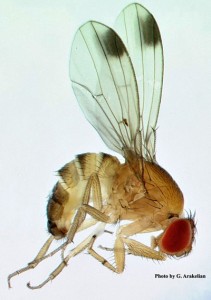
The Situation: In June 2009, spotted wing drosophila, formerly known as the cherry vinegar fly, Drosophila suzukii (Diptera: Drosophilidae), was trapped over a wide area in northern California including Santa Clara, San Benito, Santa Cruz and Monterey Counties. This fly is now considered established in California. Spotted wing drosophila is a small fly, around 2.6-2.8 mm in length, beige-yellow in color with brown bands on the abdomen. Adults have characteristic bright red eyes, and male flies have a prominent dark spot on the distal margin of the wings. This fly is native to Asia and has been recorded from China, Japan, Korea, and Thailand. This pest is also problematic in Spain and Hawaii.
The Problem: This fly causes economic damage berry crops, in particular fresh cherries, strawberries, raspberries, blackberries, and blueberries. It may also attach grapes, and perhaps some stone fruits, however this is not certain. Damage to berries is caused by white legless maggots feeding internally on fruit pulp. Female flies use their ovipositor, a type of egg laying tube, to puncture or “sting” the skin of healthy growing berries and the egg is inserted into this wound. Fluids may leak from this puncture, and often rot-type pathogens will enter the wound also causing damage. Spotted wing drosophila has short generation times. It has been estimated that during cherry fruiting season the fly may have up to 2-3 generations, and over the course of the year, perhaps as many as 10-15, depending on location and local climatic conditions. Prolonged temperatures around or in excess of 30oC (86oF) may be detrimental to fly populations.
Management: At this early stage little is known about the biology and likely economic impact this fly will have in California. University of California research scientists and extension specialists are investigating the efficacy of pesticides for killing flies in different crops. Traps and attractants are being investigated for monitoring flies, and attractants may possibly be used to lure in flies to feed on toxic baits in an “attract and kill” management strategy.
Want more? Go to the CISR website for more on Cherry Vinegar Fly
